






Gate City, is a nickname for Atlanta, which was first suggested in a toast at a banquet in Charleston in 1857, in reference to Atlanta’s famous hospitality to travelers passing through the southeast.

A Walk by a Lake Atlanta Ga.

The Creek land in the eastern part of the metro area (including Decatur) was opened to white settlement in 1823. In 1835, leaders of the Cherokee nation ceded their land to the government in exchange for land out west under the Treaty of New Echota, an act that eventually led to the Trail of Tears.
In 1836 the Georgia General Assembly voted to build the Western & Atlantic Railroad to provide a trade route to the Midwest. The initial route was to run from Chattanooga to a spot called simply "Terminus", located somewhere east of the Chattahoochee River, which would eventually be linked to the Georgia Railroad from Augusta and the Macon and Western, which ran from Macon to Savannah.
A number of sites were proposed or actually designated as the Terminus, and the history is not completely clear. In 1837, work began to build it near Hog Mountain in present-day Norcross, where Fort Daniel was located, but the site was soon abandoned because there were too many creeks, valleys, and steep gradients. It was moved to Montgomery Ferry near Fort Peachtree, for a savings of $18,000 per mile. Some historians claim that Decatur, a town founded in 1823 to the east of current-day Atlanta,Many current suburbs of Atlanta were actually prospering towns before Atlanta had its first building, including Norcross, Decatur, Marietta and Lawrenceville was proposed as the Terminus, but declined due to worries about noise and crime.
Several months later in 1837, the legislature finally established the zero-mile marker for the Terminus at a point near the present-day Georgia World Congress Center, because the area was relatively flat and would better allow for turnarounds.(The zero-mile marker was later moved a short distance east, and today sits underneath Five Points, which was built on iron pilings above the railroad.)
 Five Points
Five Points Five Points
Five PointsThe area around Atlanta, later to become a part of the city, also began to be developed. A well-marked Indian trail, known as the Peachtree Trail, had long run from the area of present-day Suwanee, Georgia to the site of Standing Peachtree. To the south, in the present-day Campbelltown Road area, the Owl Rock Methodist Church was founded in 1828 by Richmond Barge and other members of the Mutual Rights faction. In 1838, Henry Irby started a tavern and grocery on a spur of the road, and the paths leading to his establishment became Paces Ferry Road and Roswell Road. Two years later the head of a buck was mounted on a pole in front of the tavern, and the region came to be called Buck's Head and then Buckhead.
By 1842, the settlement at the Terminus had six buildings and 30 residents. When a two-story depot building was built, the residents asked that the settlement be named "Lumpkin", after Wilson Lumpkin, the Governor of Georgia. He asked them to name it after his daughter, instead, and Terminus became Marthasville. Just three years later, the Chief Engineer of the Georgia Railroad, (J. Edgar Thomson) suggested that it be renamed to "Atlantica-Pacifica", which was quickly shortened to "Atlanta". The residents approved—apparently unabashed by the fact that not a single train had yet visited—and the town was eventually incorporated as "Atlanta" in 1847.
The first Georgia Railroad freight and passenger trains arrived in 1845. In 1846, a third railroad,the Macon & Western, completed tracks to Terminus, connecting the little settlement with Macon and Savannah. The town then began to boom. In 1847, two hotels were built and two newspapers were published. The population exploded to 2,500 citizens. In 1848, the first mayor was elected, the first homicide occurred and the first jail was built. A new city council approved the building of wooden sidewalks, banned business on Sundays, and appointed a town marshal.
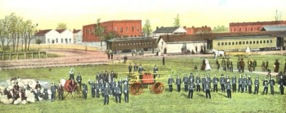
Atlanta Fire Department 1856
By 1854-55 another railroad had connected Atlanta to Chattanooga. The town had grown to 6,000 residents and had a bank, a daily newspaper, a factory to build freight cars, a new brick depot, property taxes, a gasworks, gas streetlights, a theater, a medical college, and juvenile delinquency. According to the Fulton County Grand jury, an "evil of vast magnitude, the herds of unruly and vicious boys who infest the streets of the city ... by day and night, especially on the Sabbath, to the great annoyance of (the) citizens..."
During the American Civil War, Atlanta served as an important railroad and military supply hub. In 1864, the city became the target of a major Union invasion (the subject of the 1939 film Gone with the Wind). The area now covered by Atlanta was the scene of several battles, including the Battle of Peachtree Creek, the Battle of Atlanta, and the Battle of Ezra Church. On September 1, 1864, Confederate General John Bell Hood evacuated Atlanta after a four-month siege mounted by Union General William T. Sherman and ordered all public buildings and possible Confederate assets destroyed. The next day, Mayor James Calhoun surrendered the city, and on September 7 Sherman ordered the civilian population to evacuate. He then ordered Atlanta burned to the ground on November 11 in preparation for his punitive march south.
After a plea by Father Thomas O'Reilly of Immaculate Conception Catholic Church, Sherman did not burn the city's churches or hospitals. The remaining war resources were then destroyed in the aftermath, and in Sherman's March to the Sea. The fall of Atlanta was a critical point in the Civil War, its much publicized fall giving confidence to the Northerners, and (along with the Battle of Mobile Bay) leading to the re-election of Abraham Lincoln and the eventual surrender of the Confederacy.

Famous Lamp Post
The city emerged from the ashes -- hence the city’s symbol, the phoenix - and wad gradually rebuilt. It soon became the industrial and commercial center of the south. From 1867 until 1888, U.S. Army soldiers occupied McPherson Barracks (later renamed Fort McPherson) in southwest Atlanta to ensure Reconstruction era reforms. To help the newly freed slaves, the Federal Government set up a Freedman’s Bureau, which helped establish what is now Clark Atlanta University, one of several historically black colleges in Atlanta.
In 1868, Atlanta became the fifth city to serve as the state capital. Henry W. Grady, the editor of the Atlanta Constitution, promoted the city to investors as a city of the "New South", by which he meant a diversification of the economy away from agriculture, and a shift from the "Old South" attitudes of slavery and rebellion. As part of the effort to
modernize the South, Grady and many others also supported the creation of the Georgia School of Technology (now the Georgia Institute of Technology), which was founded on the city's northern outskirts in 1885.
Mammy”s Shanty Atlanta Ga.
“Where the Peachtree’s Meet”
------------------------------------------------
ATLANTA, a flourishing city of Fulton County, known as the Gate City, from its being the grand center of all the rail-roads north, south, east, and west. The situation is elevated, and remarkably healthy. It is one of the most active business cities in the Confederacy; contains several fine churches, schools, Machine shops, and other improvements. Population about 20,000.
"Hill & Swayze's Railroad Guide"
of 1862 & 1863
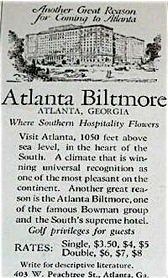
lat:334456N
long:0842317W
elev. 1,050 ft.

 "HOWELL'S MILL," FROM A WATER-COLOR DRAWING BY WILBUR KURTZ
"HOWELL'S MILL," FROM A WATER-COLOR DRAWING BY WILBUR KURTZJan. 3, 1861 Atlanta has a
10 second earthquake


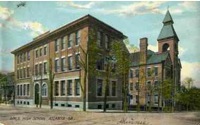
Girls High School 1910 Atlanta
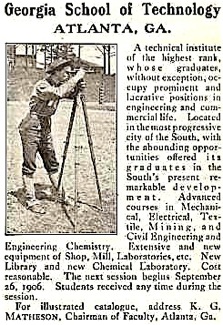
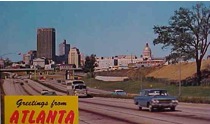

Atlanta has a total of 132.4 miles
131.8 miles of it is land
.07 miles of it is water ( .51% )

Biltmore Grill

Clark College

Marthasville was the first name
under which Atlanta was chartered, Dec.23, 1843.
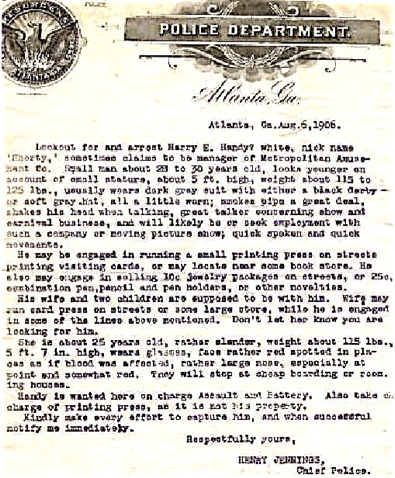



1954 Capitol, Atlanta
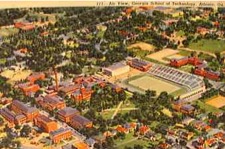
Georgia Tech 1941
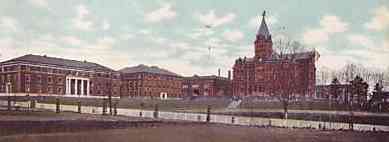
Georgia Tech 1909
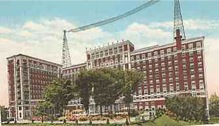
Biltmore 1930
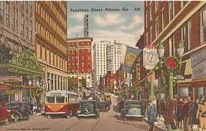
Peachtree Street 1937
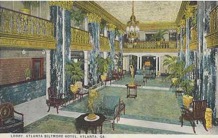
Biltmore Lobby

